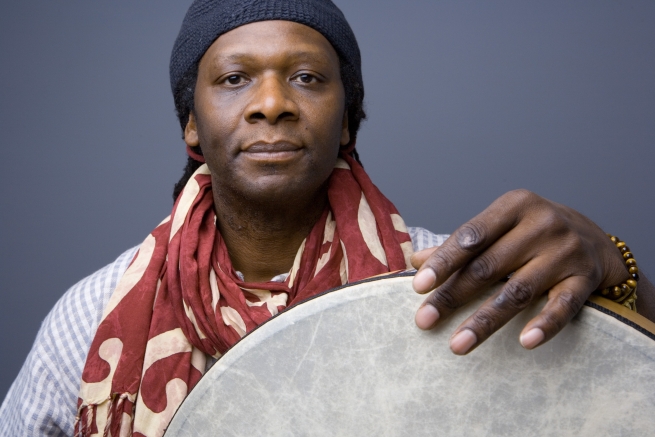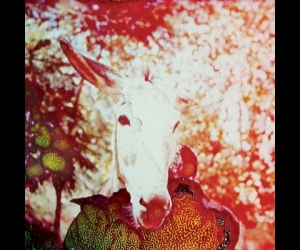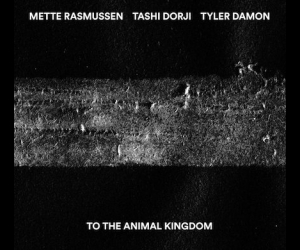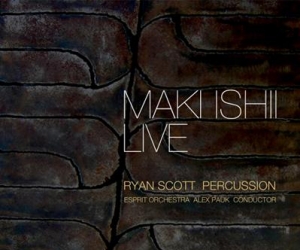
The annual Guelph Jazz Festival is always populist. In its sixteenth edition, it extended its support of outdoor improvisation, plus interaction between Third and First World musicians without lessening its commitment to Free Music. Much of the outstanding music making came from the latter, however, with American pianist Marilyn Crispell one of the standouts. She was featured in American, European and Canadian group settings.
Crispell’s playing was powerful and outer-directed at the River Run Centre in a trio with two stalwarts of the Association for the Advancement of Creative Musicians, the seemingly ageless tenor saxophonist Fred Anderson and the colourful percussionist Hamid Drake, whose rhythmic conception works well in any context. Anderson often gave quivered or vibrated renderings of reflective lines that were paralleled with linear arpeggios or kinetic pedal-pushed frequencies by Crispell. Meanwhile, Drake’s palm or stick movement conveyed all the rhythm. The climax was a version of Tisziji Muñoz’s “Fatherhood,” built on ecclesiastical chording from the pianist, ruffs and rebounds from Drake, and gospel-like preaching from Anderson.
Only one member of the Stone Quartet is European—French bassist Joëlle Léandre. Yet when she and the Yanks—trumpeter Roy Campbell, violist Mat Maneri, and Crispell—intersected with sophisticated and intuitive improvising in the sanctuary of St. George’s Church, the outcome related more to Continental sounds than American Free Jazz. Campbell, phrasing subtly, at points appeared to be breathing in notes rather than expelling them. Hand-muting asides were another favourite strategy, clutching a tone until it dissolved. Crispell rumbled or spun out connective chords, decorating the improvisations. Maneri shredded fiddle notes in a deadpan fashion, equally honouring Paganini and Stuff Smith. Léandre sometimes bowed her bass with excruciatingly heavy motions, as if physically pulling the notes from the bass, and other times sliced, diced, and rubbed timbres from the instrument while yodelling in pseudo-operatic soprano. Adapting to the moment, she emphasized her resounding pizzicato pulse.
At the River Run the next night, Crispell was featured in Ottawa bassist John Geggie’s trio with Toronto drummer Nick Fraser. Without perpetuating Canadian stereotypes, Geggie’s compositions—and the affiliated improvisations—were more cerebral and studied than those from American bands. Yet there was enough sense of space and structure to separate them from European conceptions. The bassist confined himself to thumping tone-bonding or resonating picking, leaving theme statements to the pianist’s key patterning and downshifting runs. Fraser’s inventions included irregular clip-clopping and the suggestion of bell-pealing on the Gregorian chant-based “Credo.”
Canada’s other solitude was represented by a rip-snorting performance at St. George’s Church Hall by Jean Derome et les Dangereux Zhoms + 7. The two extended performances were both postmodern pastiches in which the individual talents of the twelve musicians provided scope for the Montreal-based reedist-composer to express his heroic ideas. As Martin Tétreault’s pressurized turntable drone created a crackling ostinato, and Joane Hétu’s moist murmurs, hiccups, and yodels supplied verbal commentary, the pieces mixed rock beats from the electrified rhythm section, legato pacing from the violinist and violist, and jazz-inflected jabs from pianist Guillaume Dostaler, gutbucket blows from trombonist Tom Walsh, and expressive triplets from trumpeter Gordon Allen.
Days later at the River Run Centre, the World Saxophone Quartet was equally flamboyant playing the Hendrix Experience. Resplendent in sharp suits, the four reedists—David Murray, Tony Kofi, James Carter, and Hamiet Bluiett—were backed by Lee Pearson’s showy drumming and the electric bass of Jamaaladeen Tacuma. There were crowd-pleasing techniques, as when Pearson played with his sticks behind his back while balancing another on his head, and when Murray or Carter ripped off a series of screaming vamps while body-swaying across the stage, Southern Soul riffs and free jazz extended techniques were more obvious than any direct link to Jimi Hendrix. “Hey Joe” was announced and a snatch of “Fire” heard, but the pumped drum backbeat and finger-popping bass work alluded to Funk, not Fusion. Off to one side, Bluiett was most notable when he eschewed baritone sax snorts for a spidery, tremolo clarinet solo.
As self-effacing as others were flamboyant, Léandre’s solo performance Saturday afternoon at the Guelph Youth Music Centre ignored the bass’s percussiveness to concentrate on the instrument’s other qualities. Performing on a bare stage, Léandre at one point drew an imaginary line on the floor with her bow, then proceeded to rub arco timbres from different parts of the bass: its back, belly and bridge, as well as the strings. Clipping and clapping the strings, as well as spanking the wood and whisking the bow through the air, she encouraged sounds with body English. Creating distinctive multiphonics, she studded her improvisations with bel-canto shrieks and onomatopoeia that deconstructed the textures of certain phrases.
Solo expression had also been the leitmotif of the previous afternoon for Acoustic Orienteering, the most grandiose of the festival’s outdoor installations. A “cartographic composition” by Scott Thomson for fifteen freely improvising musicians, the forty-five-minute piece featured performers circumnavigating downtown Guelph as they played. Audience members were given maps so that they could follow particular musicians’ routes or choose a place to stay and let the players pass them. While acoustics in certain areas aided the expression of Paul Dutton’s soundsinging and the fluttering ripples from Jean Martin’s trumophone, the only provision made for musical interaction seemed to be serendipity. If a listener stayed in one place, it meant that a musician hovered into view, played a few notes while passing, then moved on.
Interactivity was on display in profusion at Mitchell Hall later that night, when veteran Ethiopian tenor saxophonist Getatchew Mekuria and dancer Melaku Belay performed with the Dutch Punk-Jazz outfit The Ex. Perform is the operative word, as Ex guitarists Andy Moor and Terrie Hessels, clad in short pants and Doc Martens, skittered and slid over the stage, unleashing feedback torrents and frenzied riffs; and trumpeter Arnold De Boer emphasized with spastic movements the lyrics he shouted; while Belay wiggled and shifted with gel-like undulations, sometimes on his feet, yet parallel to the floor, and other times upright, performing choreography halfway between the Moon Walk and the Saint Vitus’ Dance. Drummer Kat Bornefeld pounded away and, as well, contributed one echoing vocal in Amharic. As for Mekuria, who at one point topped his flowing white robes and Ethiopian-flag-coloured sash with an embroidered hat and cape, he moved regally across the stage, playing with wide vibrato—a decidedly pre-modern style that recalled swing saxophonists like Ben Webster. Yet his solos fit in with the cacophonous electronic pulse that shuddered almost visually, as well as the reed counterpoint generated by alto saxophonist Brodie West’s split tones and clarinettist Xavier Charles’ squeaks and squiggles.
A similar cultural blending had been attempted earlier that night at the River Run Centre but never achieved the same reckless exuberance. Toronto’s Woodchoppers Association and two Malian musicians created an interaction whose sum was less than its parts. Seemingly most comfortable singing gentle folk songs, the Malians adopted a simplified World Music style with the Choppers. Wearing matching white outfits, the vamping Choppers aimed for the greasy Funk the WSQ would play in lieu of Fusion, but came across as tentative improvisers.
The Guelph Jazz Festival, now a robust teenager, appears intent on exploring new sounds and fusions. With its free-music orientation solidified, experimenting this way should be a productive path to follow.
Image: Hamid Drake. Image by: Jill Newberry.


